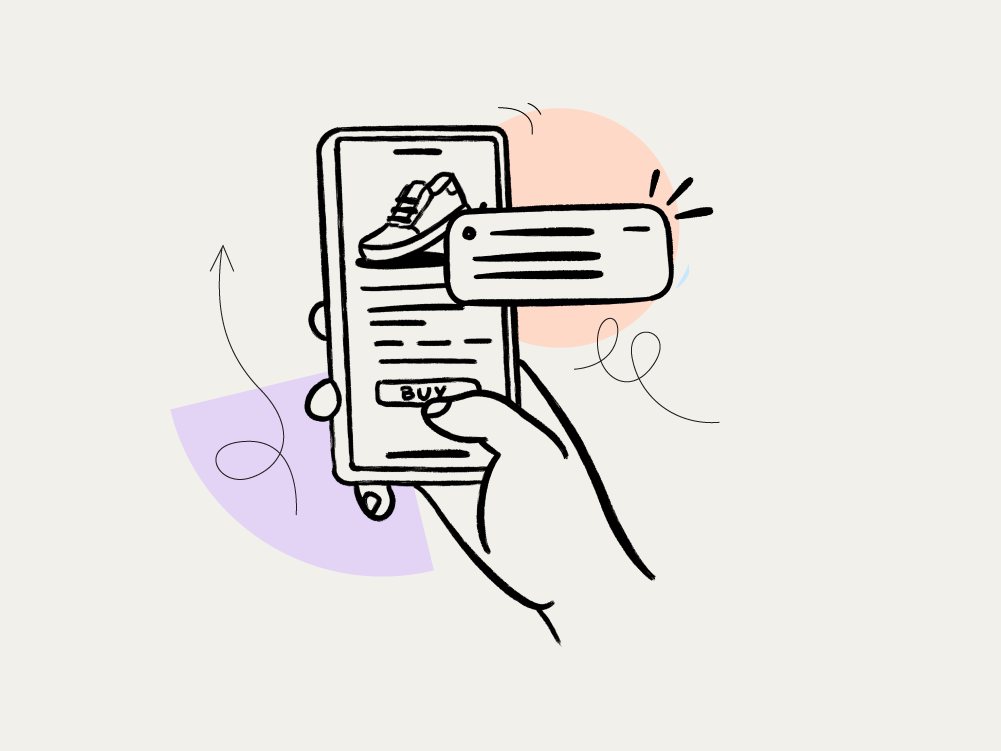Abandoned carts are the equivalent of ghosting for Shopify store owners - totally frustrating and leaving you wondering what went wrong, what you could’ve done differently to seal the deal, or how you can win them back.
According to Dynamic Yeild’s research (May 2024), the cart abandonment rates per industry are:
- Health & Beauty industry - 72.08%
- Fashion & Apparel - 76.01%
- Jewellery & Accessories - 78.7%
Although these figures may seem a bit daunting, there’s actually a lot you can do to prevent and win back those abandoned carts.
In this article, we’ll take you through…
- The top reasons for cart abandonment
- Why it’s important to solve abandoned carts
- Incorrect ways many store owners try to solve abandoned carts
- 8 tips to reduce and recover Shopify abandoned carts
Why do abandoned carts happen?
Baymard Institute’s study found that the top reasons for abandonments during cart and checkout are as follows:
%2520V2.webp)
Top 4 reasons for cart abandonment
1 - Extra costs too high
Many Shopify store owners tack on extra costs, like shipping fees or taxes, right at the end of the checkout process. They do this thinking it’ll get customers more committed upfront.
But here’s the thing: when these unexpected costs pop up out of nowhere, it can leave customers feeling blindsided and unprepared for the final bill.
The key is transparency.
Show all potential or estimated fees right from the start, or add a cost calculator tool on the checkout page to help set clear expectations for your customers.
2 - Having to create an account
A lot of websites force you to create an account before you can finish your purchase.
But let’s be real, new customers or shoppers who are looking to make a speedy purchase aren’t going to want to deal with the hassle of filling out extra forms and sharing personal information.
Let customers check out as a guest so they can complete their purchase without creating an account. Once they’re done, you can offer to save their info for next time.
3 - Concerns about payment security
With all of the data breaches, payment fraud, and identity theft going on, it’s no wonder customers are worried about their personal and financial information when shopping online.
If your website doesn’t feel secure or doesn’t clearly display security badges, SSL certificates, and clear privacy policies, customers will ditch their carts in a heartbeat.
4 - Slow delivery times
Due to the speedy shipping standards set by big online retailers, a lot of shoppers now expect to get their purchases fast and simply don’t want to wait.
If your delivery times are too long, customers are more likely to ditch their carts and opt for a quicker alternative instead.
Make sure that you clearly show estimated delivery times on product pages and during checkout. You should also offer expedited shipping options, and stick with fast, reliable delivery services.
Why is it important to solve abandoned carts?
Abandoned carts directly translate to lost revenue.
Each time a customer adds products to their cart but doesn’t complete the purchase, it’s a potential sale slipping away.
But it’s not just about the immediate sale.
When customers abandon their carts, it affects their long-term engagement and the chance they’ll come back, hitting your Customer Lifetime Value (LTV).
Plus, high cart abandonment rates drive up your customer acquisition costs.
If you’re not converting customers who've already shown interest by adding items to their cart, you’ll have to spend more on marketing and advertising to attract new ones to make up for those lost sales.
Incorrect ways store owners try to solve abandoned carts
Some Shopify store owners flood customers with multiple follow-up emails in a short period, hoping to remind them to finish their purchase. But these emails can feel overwhelming and annoying, pushing them to unsubscribe.
Implementing aggressive popups that appear repeatedly when customers are about to leave the site also creates a frustrating browsing experience, driving customers away rather than encouraging them to buy.
Then there are Store owners who immediately offer deep discounts to customers who abandon their cart in an attempt to lure them back, but doing that too often can make your products seem less valuable.

How to effectively reduce & recover abandoned carts
Reduce
Reward & loyalty programs
The promise of future discounts, free products, or exclusive offers makes the immediate purchase more attractive.
Plus, customers who participate in reward & loyalty programs spend 12%-18% more each year and show 25% higher retention rates.
Many successful online stores have shown that a smart rewards program can really help to cut down on cart abandonment. Take MAC’s Lover Loyalty Program, for instance. They let members earn points with every purchase they make.
It’s not just about stopping customers from ditching their carts to hang onto those points. It really clicks with shoppers because they can save up points for beauty products they genuinely want.
By adopting a similar approach to your store’s loyalty program, you’ll give customers a strong reason to finish their purchases and keep coming back for more.
Live chat functionality
Customers often abandon their carts because they have uncertainties or unanswered questions about products, payment options, or delivery times.
But having live chat ready to go gives them instant answers and peace of mind.
If you notice customers lingering on the checkout page for a while, use live chat to:
- Check if they need any help or have questions about checking out.
- Offer them a sweet discount or incentive to seal the deal.
- Remind them that free shipping is available for orders over a certain amount.
Gymshark’s chatbot stands out as one of the best examples of live chat on Shopify stores. It not only navigates quickly and easily through product queries and sizing information, but also integrates with popular messaging apps, such as WhatsApp, Instagram, and Facebook, meeting customers where they’re most comfortable.
Offer multiple payment options
Research by PayPal found that 59% of shoppers have abandoned their cart when their preferred payment method was unavailable.
But by offering a variety of payment options such as PayPal, Apple Pay, Google Wallet, and buy-now-pay-later services like Afterpay or Klarna, you can ensure that most, if not all, of your customers can complete their transactions using methods they commonly use and trust.
The best way to establish the most suitable choices is to get to know your customers and how they like to shop.
For example, offering Klarna as a payment option is vital for fashion & clothing stores because it allows customers to order multiple styles or sizes of clothing without too much financial strain. This flexibility reduces the barrier to purchase, encourages higher order value, and improves customer satisfaction by simplifying the return process for items that don’t fit.
Prevent technical problems
60% of consumers say they abandon purchases due to poor user experience on websites.
So it’s important to create an environment where shoppers can easily browse, select, and purchase products without coming across any technical hiccups:
1. Test the checkout process
Make sure to regularly test everything from a customer’s point of view. Go through the entire checkout process like a customer would.
This means checking load times, making sure all the form fields work right, seeing how the payment system handles usage, and just overall making sure it’s smooth sailing for customers.
2. Improve site speed and performance
78% of users feel stressed or angry when using a slow website.
To improve your site’s speed and performance, focus on optimising images, minimising heavy code scripts, and using Shopify’s built-in performance tools.
3. Replace broken links
Broken links on your website will lead customers to dead ends, hugely disrupting their shopping journey.
You can use tools link checkers, like Google Search Console and SEMRush, to scan your site for broken links. Be quick to fix or ditch any faulty links so your visitors can navigate smoothly without hitting any dead ends.
Get a mobile app for your Shopify store
Shopify mobile apps are much more effective at limiting abandoned carts than websites.
They provide customers with a simplified or one-click checkout process. When you remove unnecessary steps and friction points that can deter shoppers, you’re also removing the impatience and frustration that often leads to cart abandonment.
Mobile apps also let you send push notifications, which are messages that pop up on your customers’ phones even if they’re not using your app. They’re handy for things like letting customers know when an item is back in stock or when there’s a flash sale, like ‘20% off jewellery and accessories.’
But they’re also great for re-engaging customers who have left items in their cart or haven’t shopped with you in a while. Sending them a personalised message can remind them about those items and encourage them to come back.
As part of our Shopify growth service, we offer a no-code Shopify mobile app builder to help further grow your business and electrify your sales. Learn more about our plans here or chat with one of our Shopify growth experts.
Recover
Retargeting Ads
These ads act as targeted reminders of customers who expressed initial interest by adding items to their cart but didn’t end up completing their purchase.
This approach is effective because cart abandoners are typically near the end of the conversion funnel. Often, just a small push is enough to persuade them to click buy.
1. Create visually appealing content
In the fashion, jewellery, and beauty industries, aesthetics sway what people buy.
Your retargeted ads need to show off your products in the best light possible, that’s in a high-quality and eye-catching appeal - enough to bring customers back and entice them to seal the deal on their purchase.
2. Tailor your ads
Tailored content doesn't just make a brand look good—it actually makes customers up to 40% more likely to engage with ads and buy something.
So, create personalised messages that speak directly to what customers have been checking out, like showing them the exact items they were interested in.
3. Use multiple platforms
Throughout the day, customers engage with various online platforms such as social media, search engines, and various websites.
By using multiple platforms, you can ensure that your retargeting ads grab the attention of customers from wherever they spend their time online.
Exit-Intent Pop-Ups
Exit intent popups can detect when a customer is about to leave your Shopify store without completing their purchase. Their job is to swoop in and capture the customer’s attention at this critical moment and encourage them to stay and finish their transaction.
However, it’s important to use them correctly. You don’t want them to annoy your customers so much they leave your site altogether.
The most effective exit-intent pop-ups include flash deals, cart reminders, and free shipping codes.
This strategy helps you capture sales that would otherwise be lost or abandoned, increasing conversion rates by an average of 20%. Plus, it shows your customers that you value their business and are willing to offer incentives to keep them engaged.
Cart Abandonment Emails
Cart abandonment emails are super effective - they get opened 45% of the time, with 21% receiving click-throughs.
But here's the key - a great abandoned cart email isn’t just a reminder. It’s all about rekindling that customer interest and guiding them back to finish the purchase they started.
When you send these emails, be sure to also gently jog shoppers’ memories about what’s waiting in their cart, such as with an itemised list with clickable links.
Sometimes shoppers abandon their cart because they couldn’t find exactly what they were looking for. That’s where suggesting similar or complementary items, such as accessories, can really reel them back in. Adding a discount code could also help to sweeten the transaction and get customers to think twice before leaving their cart behind.

You might also be interested in
For Fashion & Apparel, Health & Beauty, and Jewellery & Accessory stores, one of the biggest Shopping events of the year is Shopify Black Friday Cyber Monday.
However, due to increased competition and an overwhelming amount of choices, cart abandonment is very high during Shopify Black Friday Cyber Monday, sitting between 77% and 82%.
However, it’s not all doom and gloom. This weekend-long event can also be the easiest time to turn those carts into conversions.
If you’d like to learn more about how to reduce abandoned carts on Shopify Black Friday Cyber Monday 2025, you can read our article, or talk to one of our Shopify growth experts.

Skyrocket your Shopify sales with a no-code Apple & Android mobile app. Available now on the Shopify app store.















.webp)
